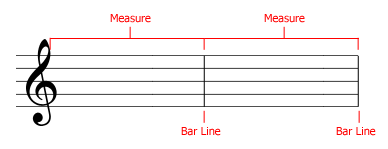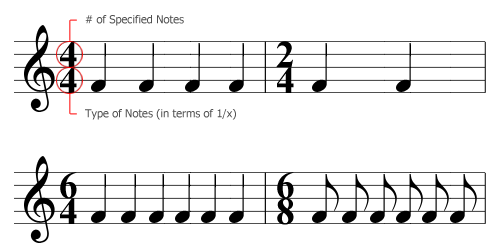When reading sheet music, understanding the concepts of bar lines, measures, and time signatures is essential. These elements help organize musical notes and rhythms in a structured way, allowing musicians to interpret the timing and flow of the music accurately.
Bar Lines and Measures
In music notation, the staff (the five horizontal lines on which notes are written) is divided into smaller sections called measures (or bars). These measures help to group notes into manageable segments, making it easier to read and perform the music. Measures are separated by bar lines, which are vertical lines that span the height of the staff.

In the image above, you can see two measures on a staff, clearly divided by two vertical bar lines. Each measure contains a specific number of beats, determined by the time signature (more on that later). The purpose of measures is to organize the music into rhythmic units, helping musicians stay in time and understand the underlying structure of the composition.
Time Signatures: Defining the Rhythm of Measures
A time signature tells the musician how many beats are in each measure and what type of note gets the beat. It is written as two numbers stacked vertically at the beginning of a piece of music (or at the beginning of a new section if the time signature changes).
- The top number indicates how many beats there are in each measure.
- The bottom number tells you which note value represents one beat.
Let’s break this down with some examples, as understanding time signatures is best done through visualizing how they work.

In the image above, we have four examples of time signatures, each defining a different rhythmic structure within the measures.
- 4/4 Time Signature (Common Time):
This is one of the most frequently used time signatures in music. The top number “4” indicates that each measure contains four beats. The bottom number “4” tells us that the quarter note (1/4 note) gets one beat. In this case, the measure must contain notes that add up to the equivalent of four quarter notes. For example, it could be four quarter notes, one whole note, or any combination of notes that sums up to four beats. - 2/4 Time Signature:
Here, the top number “2” tells us that there are two beats in each measure, while the bottom “4” indicates that each beat is a quarter note. This time signature is often used in marches and other types of music with a “two-step” feel. Each measure will have the same duration as two quarter notes. You can read more about note duration here. - 6/4 Time Signature:
In this example, the top number “6” indicates that there are six beats in each measure, with the quarter note still getting the beat (as indicated by the bottom number “4”). So, each measure will have the same duration as six quarter notes. This time signature is common in more complex or expansive musical phrases. - 6/8 Time Signature:
This time signature operates slightly differently from the previous examples. Here, the top number “6” means that there are six beats in each measure, but the bottom number “8” shows that the eighth note (1/8 note) receives one beat. Therefore, each measure will have the equivalent duration of six eighth notes. This time signature often gives music a lilting or “triplet” feel, common in genres like waltzes or folk music.
Breaking Down Time Signatures
Let’s explore the components of a time signature more deeply:
- Top Number (Beats per Measure):
This number tells us how many beats are in each measure. It could be any number, depending on the complexity of the rhythm. In simpler time signatures like 4/4 or 3/4, the number of beats is fairly straightforward. However, more complex time signatures like 5/4 or 7/8 indicate uneven or irregular groupings of beats. - Bottom Number (Note Value per Beat):
The bottom number indicates which type of note gets one beat. Common values include:- 4: The quarter note gets one beat.
- 8: The eighth note gets one beat.
- 2: The half note gets one beat.
Examples of Time Signatures in Music
Time signatures are not only crucial for rhythm but also give pieces their characteristic “feel.” Here are some common examples of how different time signatures shape the music:
- 4/4 Time (Common Time):
Found in genres ranging from rock to classical to jazz, 4/4 time is by far the most used time signature. It creates a steady, even rhythm that’s easy to follow. Songs like “Let It Be” by The Beatles or “Billie Jean” by Michael Jackson are written in 4/4 time. - 3/4 Time:
Known as “waltz time,” 3/4 time is often used in classical waltzes and ballads. It gives the music a flowing, dance-like quality, with three beats per measure. An example of 3/4 time is Johann Strauss’s “The Blue Danube.” - 6/8 Time:
This time signature gives a rhythmic grouping of six beats per measure, often subdivided into two groups of three, creating a rolling, compound rhythm. It’s commonly used in folk and classical music. An example of 6/8 time is “House of the Rising Sun” by The Animals.
Conclusion: Mastering Bar Lines, Measures, and Time Signatures
Understanding bar lines, measures, and time signatures is key to reading and performing music effectively. Bar lines organize the notes into measures, making it easier for musicians to follow the rhythm. Time signatures, on the other hand, dictate the structure of each measure, telling you how many beats are in the measure and which note value gets the beat.
Mastering these elements allows you to better understand the music you’re playing and ensures that you stay in sync with the rhythm. Whether you’re playing in 4/4, 3/4, or experimenting with more complex time signatures, this knowledge is foundational to becoming a skilled musician.
- Want to improve your guitar playing?
-
These lessons have been written by me, a guitar enthuthiast. I've written them to the best of my abilities, but I'm no guitar teacher!
If you want award-winning, well structured but inexpensive lessons, I strongly recommend you check out Guitar Tricks. They have great range of video guitar lessons from numerous coaches specialising in a wide range of styles.
I've seen their videos, and they're great. With these guys, I'm confident you'll be improving in no time!
